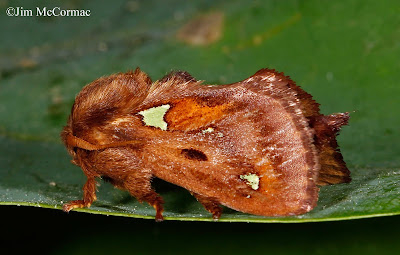A Rosy Maple Moth, Dryocampa rubicunda, glares menacingly at your blogger. Well, as menacingly as a pink and yellow animal can manage.
Our extreme mothing efforts at the recent Mothapalooza conference paid great dividends. Scads of species great and small were seen, and in most cases, photographed. I'll share a smattering of my efforts here.
By the way, dates have been confirmed for Mothapalooza IV. The conference will be back at Shawnee State Park Lodge, August 5 thru 7, 2016. The later date will provide a somewhat different cast of moth characters, and the crop of caterpillars will be much advanced. You won't want to miss it. The link to the Mothapalooza website is RIGHT HERE.
This is one of our largest moths, the Royal Walnut Moth, Citheronia regalis. Its larva IS the biggest caterpillar, the fabled Hickory Horned Devil, which is nearly the size of a small hotdog. I have written about them HERE, and HERE.
The giant silkmoths, such as this, always elicit oohs and aahs. But cool as the jumbo silks are, one soon learns that many of the smaller - often MUCH smaller - moths best them in ornateness.
An extravagant animal indeed, and its beauty is reflected in the name: Glorious Hybrosyne, Habrosyne gloriosa. One never seems to see many of these, but a few made their way to our sheets, generating lots of excitement.
This one looks like an artist took a pen to its wings, and drew crazy op art. It's a Zebra Conchylodes, Conchylodes ovulalis. The subjects of this photo and the last were shot in situ; on the white illuminated sheets to which they were drawn. I refer to such backdrops as "white sheets of death" when it comes to making photographs, and only fire off shots under such conditions when I don't think there's any other way I'll get an image. In my view, it's impossible to get a really stunning photo on such substrates.
We have discovered a nearly infallible rule to handling moths. If they're small and/or smooth, you cannot manipulate them. Touch one like this and its off like a rocket. However, the fuzzier and/or larger the moth, the easier they are to handle and move to better backdrops. Most of the following images' subjects were placed on nearby objects that provided for a much better image than a brightly lit white sheet.
This little moth is truly fuzzy, as is its caterpillar. It's a Black-waved Flannel Moth, Lagoa crispata. The larva looks a bit like a turtle covered in brown shag carpet, and it can deliver a punishing sting via sting hairs.
From a photographer's perspective, moths are fun to explore from different angles. Certain ones, such as this, lend themselves well to head-on views. Black-waved Flannels, like so many of the exceptionally fuzzy species, are usually quite easy to handle and move around.
This Eastern Tent Caterpillar Moth, Malacosoma americanum, looks a bit like a charging bighorn sheep. In its larval stage, this moth is much derided. They're the caterpillars that form the large conspicuous silken nests on cherry trees in the spring.
A Rose Hooktip, Oreta rosea, stunning in colors of lemon and peach. Their caterpillars feed on native viburnums such as Arrowwood, Viburnum dentatum.
Ah! A personal favorite, and a stellar bark mimic if there ever was one (and there are lots)! It's a Common Lytrosis, Lytrosis unitaria, and it looks as if it was artfully carved from wood.
Here we have camouflage taken to the ultimate. The sneakiest turkey hunter clad in the best ghillie suit couldn't hope to match this. It is a White-blotched Heterocampa, Heterocampa umbrata, and even though the moth fills the frame and the image is tack sharp, it is tough to see. Such cryptic coloration and patterning serves these moths well as they hide from birds and other predators during the day.
One that was new to me, the Small Necklace Moth, Hypsoropha hormos. With some 2,500 moth species in Ohio, bagging lifers isn't too hard for most of us. Its caterpillar nosh on persimmon and sassafras.
I had to violate my "white sheet of death" rule to make this image of a moth known as The Chevron, Eulithis testata. Being small and smooth, we would have had little chance of successfully relocating it. However, by getting my camera near the sheet and shooting sideways at the moth's level, it mitigated some of the sheet glare. Note how the moth holds its abdomen arched up and over its head. That's probably disruptive camouflage, helping it to blend in with the twigs and branches it probably hides on during the day.
Many of us reminisced on good memories afield with Dennis Profant whenever we saw slug moths, which were probably his favorite group of Lepidopterans. This one is a Spiny Oak Slug Moth, Euclea delphinii. Its caterpillar is incredible. CLICK HERE for a post that I made on slug moth caterpillars, which includes an image of this species' caterpillar.
Finally, the strange little Yellow-shouldered Slug Moth, Lithacodes fasciola. It and most of its slug moth ilk are small enough to be overlooked among the comparative giants of the moth world. But one of the great pleasures of mothing is learning to pay close attention to the little guys, which often are the showiest animals on the sheet.
Put Mothapalooza on your calendar for next year. If you like natural history in all its varied forms, you'll like Mothapalooza.













No comments:
Post a Comment